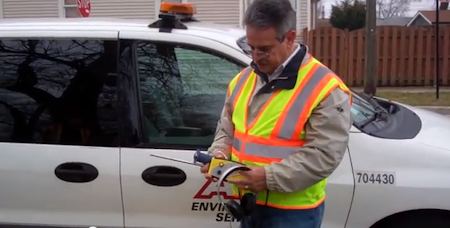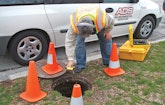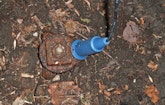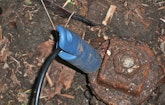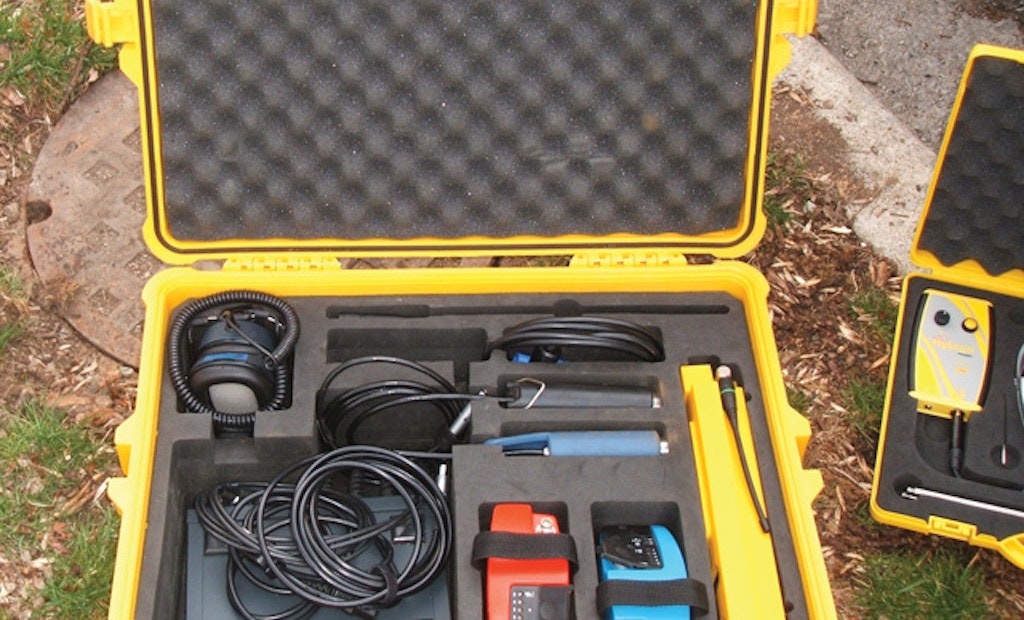Interested in Flow Control?
Get Flow Control articles, news and videos right in your inbox! Sign up now.
Flow Control + Get AlertsLeak-detection technology continues to get smaller, easier to use, and more precise. With pinpoint leak-location equipment, workers can target excavation for repairs more precisely, avoiding the disruption and expense of unnecessarily large digs or “dry holes” that find nothing.
ADS Environmental Services, a unit of ADS LLC, distributes and supports leak-detection devices manufactured for ADS under private label by Primayer Ltd. ADS LLC is a U.S. based water and wastewater products and services company and is a business unit of IDEX Corporation.
Many products ADS sells are complementary, deployed together in a systematic procedure that methodically narrows down the location of a leak. Two recent entries often used in tandem are the Hykron listening system and the Eureka 2R correlating system. These devices are designed for ease of use without extensive training, especially by general utility workers. ADS employees Luis Mijares, senior business development manager, and William Doyle, project manager, demonstrated the equipment in Chicago on April 7.
Walk-around
The Hykron system is an acoustic listening device consisting of an accelerometer, microphone, headphones, and a simple handheld control unit containing just two keys: a push-to-listen button, and a volume control.
The microphone is just a little larger than an empty cardboard toilet paper roll. It has a magnet mounted at one end to hold it in place on a hydrant, valve or other water-service fixture to listen for a leak. While it can be lowered by its power cord into a manhole, extension rods can be attached to extend its reach. The Hykron is powered by a conventional 9-volt battery. Although the unit is turned on as soon as the microphone is plugged in to the controller, the push-to-listen button helps prolong battery life.
The Eureka 2R dual radio locator set includes two transmitters, one blue and one red, with screw-on antennas. Each unit includes a plug-in transducer listening device with a magnetic base, again for attaching to water service fixtures. The locators are powered by rechargeable nickel-cadmium batteries. The carrying case includes a built-in recharger that can be plugged into a conventional outlet or automotive cigarette lighter.
A handheld control unit, essentially a miniature computer, is included with the transmitters. The control unit has a liquid crystal display view screen and a simple control panel. The panel consists of a numbered keypad like a telephone’s and unlabeled keys that correspond to a menu the view screen displays when it is turned on. In use, the two transmitters receive sound from a leak and send the information to the control device, which uses it to calculate a leak’s location between the two units.
Operation
Mijares and Doyle demonstrated the technology in a residential neighborhood on the South Side of Chicago at a site where Doyle had previously detected leaks for the city, with which ADS has a leak-detection contract.
Before the demonstration, Doyle had surveyed the neighborhood for leaks and had found one near the intersection of W. 109th Street and S. Whipple Street.
Mijares unpacked the Hykron from its case and attached its handheld control unit with a power cord tether. After Doyle opened a manhole over a water valve, Mijares lowered the Hykron by its power cord until the magnet on the face of the microphone clicked solidly on the valve. With the earphones on, he turned on the controller.
Through the earphones, a steady rushing noise could be heard: the sound of water passing through a leak. Water passing through a sealed pipe would not be audible, although a T-joint or a service could also create that sound.
Having established the presence of a leak somewhere in the vicinity, they set out to narrow down the location using the Eureka 2R locators.
Mijares unpacked the transmitters and their control panel, screwed the antennas on each locator, and plugged in their microphone cords, which turned them on. At the same manhole where he had deployed the Hykron, he placed the blue locator unit on the ground and lowered its microphone so it could attach to the valve via the magnet.
Doyle, meanwhile, used a measuring wheel to record the exact distance from the service manhole to a hydrant believed to be on the opposite side of the leak. There he attached the red locator unit’s microphone. “Both this valve and that hydrant are connected to that pipe,” Mijares said. “Those are going to be our two listening points.”
Once the transmitters were positioned and their control unit was turned on, Mijares observed the system’s findings on the control’s view screen. Each transmitter sent a signal to the control unit, and the view screen displayed a graph consisting of numerous vertical lines. One end of the graph represented the blue transmitter, the other end represented the red one.
Based on differences in the signals from the two transmitters, the control unit automatically calculated the relative position of the leak between the two units, displaying that point with a sharp upward spike in the graph.
Mijares used the control’s keypad to enter the distance Doyle had measured between the two transmitters (326 feet) and to enter information about the water pipe (8-inch cast iron). He then punched a key on the panel to correlate, and within seconds, the device calculated the leak location, illustrated by the spike as 38.4 feet from the blue transmitter unit and 287.6 feet from the red unit.
Using the measuring wheel to ascertain the distance, Mijares then walked back from the blue unit 38.4 feet. He then used a Mikron ground microphone to further pinpoint the leak’s location. (This product was the subject of a “Technology Test Drive” in the April 2010 issue of MSW.)
“The correlator will get us close, and how close is going to depend on how accurate the information is that you put into it, based on our knowledge of the pipe configuration and properties,” Mijares said. “The ground microphone puts you right on top of it. So before you mark it and dig, you want to make sure that you’re as close to it as possible.”
Walking a straight line along the underground water pipe, Mijares periodically stopped, rested the Mikron on the ground, and took a reading with the unit’s control panel, which displayed a two-digit number. The number increased from one reading to the next, indicating that the leak was closer. When the number decreased on a subsequent reading, Mijares knew he had passed the leak and was moving away from it.
Because Doyle had previously carried out this same procedure under the ADS contract with the city, he had already marked the spot of the suspected leak location with spray paint. Once the location was pinpointed with the equipment, Doyle opened a nearby sewer manhole. There, water could be seen flowing into the line that was almost certainly coming from the leaking water main.
Observer comments
With both the Hykron and the Eureka 2R units, as well as the Mikron device, the distinctive sound of the leak was readily apparent as a steady rushing noise. The controls for the devices were simple and easy to understand. It appeared that very little training would be required for utility workers to operate the devices and understand the information they put out. The Eureka 2R controls are based on a simple on-screen menu, which contributes to its ease of use.
Manufacturer comments
Mijares explained that while a conventional, properly working pipe would not ordinarily produce any noise, T-joints and services could produce a sound similar to a leak. When using the system, therefore, it’s important to check maps for any such features that could complicate interpretation of a sound. “Like any leak-detection equipment, it tells you that there’s a noise there,” he said. “It’s up to the operator to determine whether it’s a leak.”
Additionally, differences in materials can change the response of the system, so that if a line is made of one material, but patched with another, that could add some uncertainty to the exact location with the correlator system.
WATCH IT IN ACTION
To learn more about the ADS Environmental Services equipment featured in this Technology Test Drive, view the video at www.mswmag.com.
